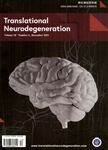Aberrant functional connectivity network in subjective memory complaint individuals relates to pathological biomarkers
作者机构:Department of Radiology2nd Affiliated Hospital of Zhejiang University School of MedicineNo.88 Jie-fang RoadShang-cheng DistrictHangzhou 310009China Department of Neurology2nd Affiliated Hospital of Zhejiang University School of MedicineZhejiangChina 不详
出 版 物:《Translational Neurodegeneration》 (转化神经变性病(英文))
年 卷 期:2018年第7卷第1期
页 面:275-284页
核心收录:
基 金:Data collection and sharing for this project was funded by the Alzheimer’s Disease Neuroimaging Initiative(ADNI)(National Institutes of Health Grant U01 AG024904)and DOD ADNI(Department of Defense award number W81XWH-12-2-0012) This study was funded by National Key Research and Development Program of China(Grant No.2016YFC1306600) Zhejiang Provincial Natural Science Foundation of China(Grant Nos.LZ14H180001 and Y16H090026) Young ResearchTalents Fund,Chinese Medicine Science,and Technology Project of Zhejiang Province(Grant No.2018ZQ035) the Fundamental Research Funds for the Central Universities(No.2017XZZX001-01) Zhejiang Medicine and Health Science and Technology Program(2018KY418)
主 题:Subjective memory complaint Functional connectivity Graph theoretical analysis Neuropathology Eigenvector centrality Degree centrality
摘 要:Background:Individuals with subjective memory complaints(SMC)feature a higher risk of cognitive decline and clinical progression of Alzheimer’s disease(AD).However,the pathological mechanism underlying SMC remains *** aimed to assess the intrinsic connectivity network and its relationship with AD-related pathologies in SMC ***:We included 44 SMC individuals and 40 normal controls who underwent both resting-state functional MRI and positron emission tomography(PET).Based on graph theory approaches,we detected local and global functional connectivity across the whole brain by using degree centrality(DC)and eigenvector centrality(EC)***,we analyzed amyloid deposition and tauopathy via florbetapir-PET imaging and cerebrospinal fluid(CSF)*** voxel-wise two-sample T-test analysis was used to examine between-group differences in the intrinsic functional network and cerebral amyloid ***,we correlated these network metrics with pathological ***:The SMC individuals showed higher DC in the bilateral hippocampus(HP)and left fusiform gyrus and lower DC in the inferior parietal region than *** all subjects,the DC of the bilateral HP and left fusiform gyrus was positively associated with total tau and phosphorylated ***,no significant between-group difference existed in EC and cerebral amyloid ***:We found impaired local,but not global,intrinsic connectivity networks in SMC *** the relationships between DC value and tau level,we hypothesized that functional changes in SMC individuals might relate to pathological biomarkers.



